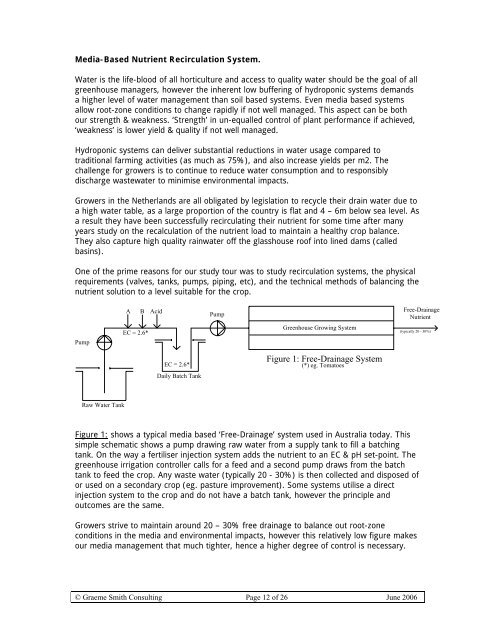GRAEME SMITH CONSULTING Hydroponic Consultancy Services ...
GRAEME SMITH CONSULTING Hydroponic Consultancy Services ...
GRAEME SMITH CONSULTING Hydroponic Consultancy Services ...
Create successful ePaper yourself
Turn your PDF publications into a flip-book with our unique Google optimized e-Paper software.
Media-Based Nutrient Recirculation System.<br />
Water is the life-blood of all horticulture and access to quality water should be the goal of all<br />
greenhouse managers, however the inherent low buffering of hydroponic systems demands<br />
a higher level of water management than soil based systems. Even media based systems<br />
allow root-zone conditions to change rapidly if not well managed. This aspect can be both<br />
our strength & weakness. ‘Strength’ in un-equalled control of plant performance if achieved,<br />
‘weakness’ is lower yield & quality if not well managed.<br />
<strong>Hydroponic</strong> systems can deliver substantial reductions in water usage compared to<br />
traditional farming activities (as much as 75%), and also increase yields per m2. The<br />
challenge for growers is to continue to reduce water consumption and to responsibly<br />
discharge wastewater to minimise environmental impacts.<br />
Growers in the Netherlands are all obligated by legislation to recycle their drain water due to<br />
a high water table, as a large proportion of the country is flat and 4 – 6m below sea level. As<br />
a result they have been successfully recirculating their nutrient for some time after many<br />
years study on the recalculation of the nutrient load to maintain a healthy crop balance.<br />
They also capture high quality rainwater off the glasshouse roof into lined dams (called<br />
basins).<br />
One of the prime reasons for our study tour was to study recirculation systems, the physical<br />
requirements (valves, tanks, pumps, piping, etc), and the technical methods of balancing the<br />
nutrient solution to a level suitable for the crop.<br />
Pump<br />
Raw Water Tank<br />
A B Acid<br />
EC = 2.6*<br />
Daily Batch Tank<br />
Pump<br />
Greenhouse Growing System<br />
Figure 1: Free-Drainage System<br />
EC = 2.6* (*) eg. Tomatoes<br />
© Graeme Smith Consulting Page 12 of 26 June 2006<br />
Free-Drainage<br />
Nutrient<br />
(typically 20 - 30%)<br />
Figure 1: shows a typical media based ‘Free-Drainage’ system used in Australia today. This<br />
simple schematic shows a pump drawing raw water from a supply tank to fill a batching<br />
tank. On the way a fertiliser injection system adds the nutrient to an EC & pH set-point. The<br />
greenhouse irrigation controller calls for a feed and a second pump draws from the batch<br />
tank to feed the crop. Any waste water (typically 20 - 30%) is then collected and disposed of<br />
or used on a secondary crop (eg. pasture improvement). Some systems utilise a direct<br />
injection system to the crop and do not have a batch tank, however the principle and<br />
outcomes are the same.<br />
Growers strive to maintain around 20 – 30% free drainage to balance out root-zone<br />
conditions in the media and environmental impacts, however this relatively low figure makes<br />
our media management that much tighter, hence a higher degree of control is necessary.


